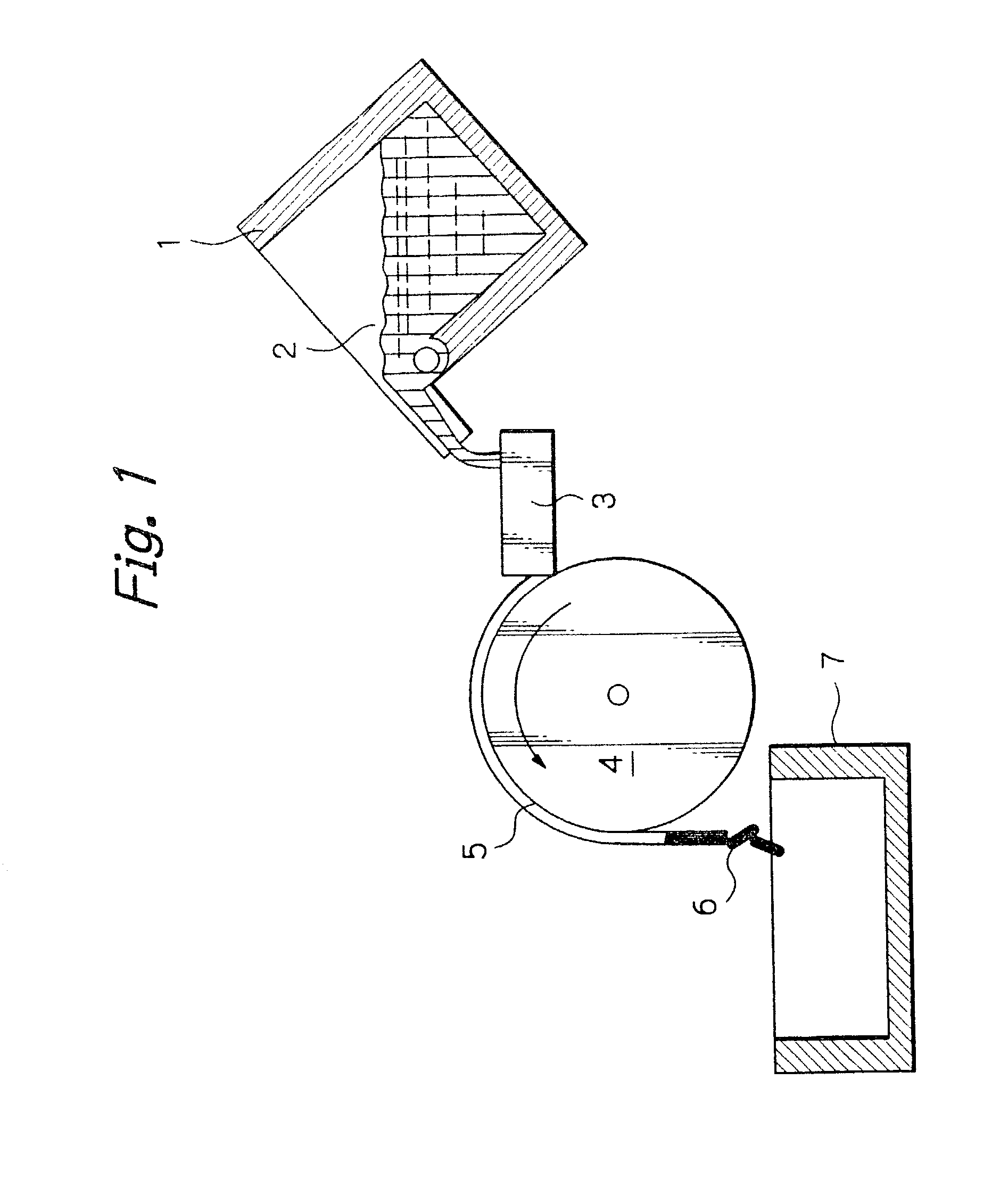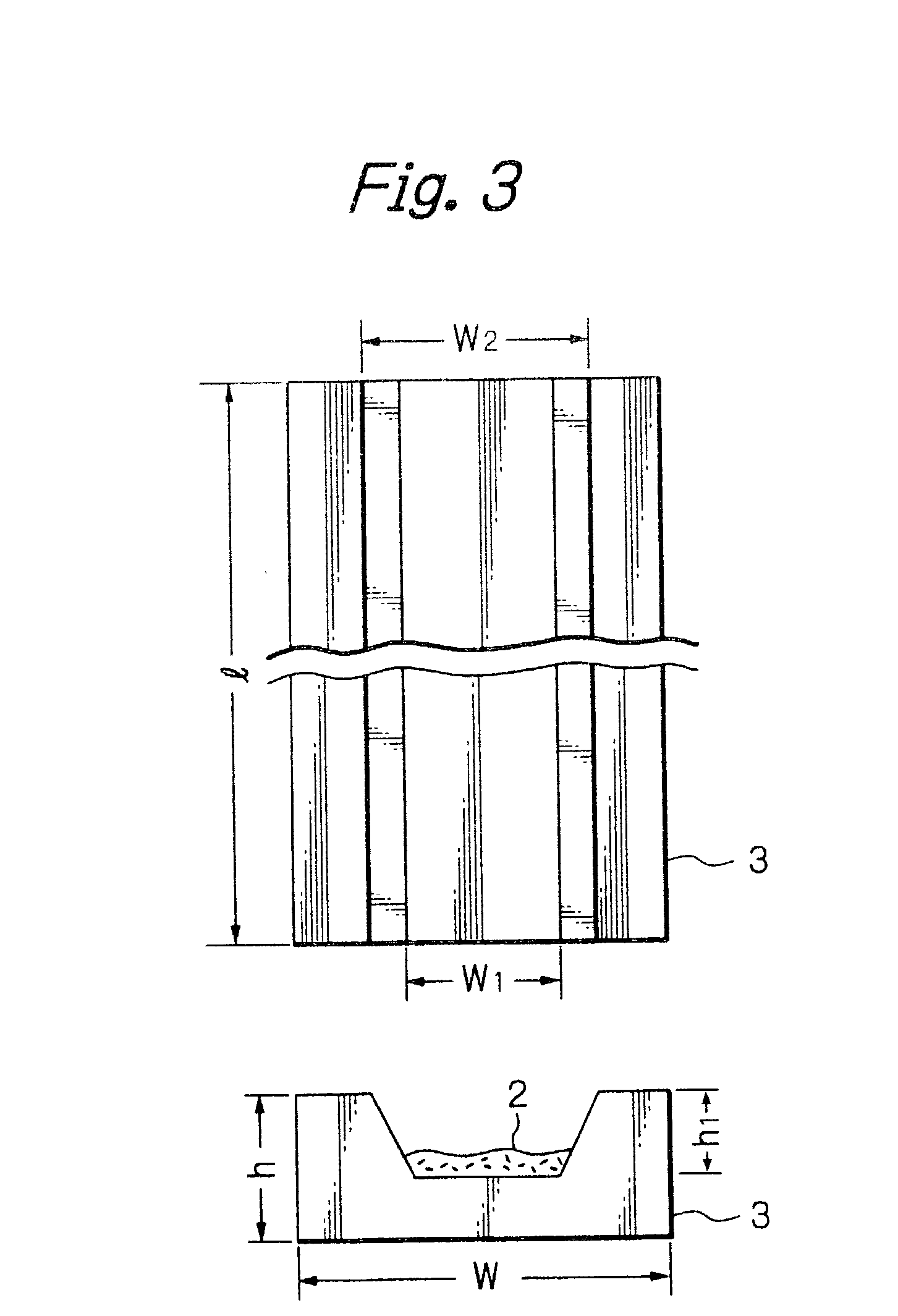[0025] The refractory material of the present first invention is based on Al.sub.2O.sub.3--SiO.sub.2. The content of Al.sub.2O.sub.3 based on the weight of the total components including a binder and the like is 70 wt % or more. The content of SiO.sub.2 is 30 wt % or less. Since the
heat resistance is enhanced with the increase in the content of the refractory constituent Al.sub.2O.sub.3, the Al.sub.2O.sub.3 content amounting to 70 wt % or more is necessary to impart to the refractory material sufficient
heat resistance in the temperature range of 1200.degree. C. to 1500.degree. C. On the other hand, the post-shaping
formability of the refractory material is enhanced with the increase in the SiO.sub.2 content, and fracture of the refractory material is difficult to occur when subjected to
thermal impact during casting. However, since the Al.sub.2O.sub.3 content is lowered with the increase in the SiO.sub.2 content, the heat-resistant temperature of the refractory material is lowered. For this reason, the SiO.sub.2 content should be 30 wt % or less. Preferably, the Al.sub.2O.sub.3 content is 80 wt % or more, and the SiO.sub.2 content is 20 wt % or less.
[0029] In order to decrease the
thermal conductivity to as low a level as possible,
alumina fiber (3.87 g / cm.sup.3 of true density) is more preferred than
alumina powder which is liable to be densely packed. The content of
alumina fiber is preferably 70 wt % or more. Particularly, the direction of alumina fibers should not be aligned but the alumina fibers should be randomly arranged and entwined. Similarly, the
thermal conductivity can be decreased by means of adjusting the refractory components such that 70 wt % or more of alumina
fiber and
mullite fiber (3.16 g / cm.sup.3 of true density) in total is contained in the refractory material. Incidentally, the SiO.sub.2 is contained in the
mullite fiber. In addition, the SiO.sub.2 may be contained in the refractory material as
colloidal silica or colloidal
mullite.
[0034] The refractory material of the present second invention is based on ZrO.sub.2. The content of ZrO.sub.2 based on the total components including a binder and the like is characterized by 70 wt % or more, and one or more of Y.sub.2O.sub.3, Ce.sub.2O.sub.3, CaO, MgO, Al.sub.2O.sub.3, TiO.sub.2 and SiO.sub.2 is characterized by 30 wt % or less. Pure ZrO.sub.2 has a monoclinic structure at from
room temperature to 1170.degree. C., is a distorted tetragonal at from 1170 to 2370.degree. C., and is cubic in the form of a
fluorite structure at 2370.degree. C. or higher. Along with the transformation from the tetragonal to monoclinic structure at 1170.degree. C. in the cooling,
volume expansion by 4% takes place. ZrO.sub.2 cracks and finally is ruptured as long as it is kept pure (for example, K. Nakajima, S. Shimada:
Solid State Ionics, Vol. 101-103, p131-135 (1997)). Its structure is, therefore, modified to an isometric
system, where no
volume expansion takes place, to prevent rupture. For this purpose, one or more of Y.sub.2O.sub.3, Ce.sub.2O.sub.3, CaO or MgO, is added to and substitution-dissolved in ZrO.sub.2 The so-stabilized zirconia is preferably used. In addition, addition of one or more of Al.sub.2O.sub.3, TiO.sub.2 and SiO.sub.2 is effective for improving the
heat resistance and durability of the mechanical properties. Their addition amount is limited to 30 wt % or less, for the following reasons: rupture is satisfactorily prevented; the solute amount of these components in ZrO.sub.2 is limited; Y.sub.2O.sub.3 and Ce.sub.2O.sub.3 are expensive; and the further addition of CaO, MgO, Al.sub.2O.sub.3, TiO.sub.2 and SiO.sub.2 added in a large amount enhances reactivity with the melt. More preferable addition amount of these in large amount components is in the range of from 1 to 15 wt %.
[0044] For example, water glass,
colloidal silica and the like can be used as the inorganic binder. For example, ethyl
silicate,
ethyl cellulose and
triethylene glycol can be used as the organic binder. These two kinds of binder may be used together. In this case, the dried strength of a shaped body and its
bonding strength at high temperature can be further enhanced. Here, the amount of binder is preferably from 1 to 30 weight parts based on 100 weight parts of the fiber. With regard to the proportion within a binder, the organic binder is preferably from 50 to 100 weight parts based on 100 weight parts of the total binder.
[0053] The above-described
tundish is a vessel which receives a melt of the rare-earth alloy from a
melting furnace or a
ladle, and which is provided with a pouring aperture for adjusting the pouring speed required for obtaining a thin-cast product. Since the amount of melt flowing on a tundish is small in the centrifugal casting method or a strip-casting method, the above-described heat-abstraction problems of the melt occur. Next, a trough is a form of the tundish used in the centrifugal casting method and the strip-casting method for guiding the melt into a tundish, in a case where the
melting furnace and the tundish are located considerably distant. A
nozzle is a pouring aperture provided in the tundish or trough described above or a passage means for guiding the melt onto a rotary roll. Particularly, the nozzles of a tundish used for the centrifugal casting enable control of the accumulating speed of the melt on the inner surface of the rotary cylinder. In addition, when a tundish is used for the strip-casting, the melt in the form of laminar flow can be poured on a single roll or twin rolls at a
constant speed. When the amount of melt per pouring is as small as a few tens of kg, the melt may be directly fed from a vessel such as a
ladle onto the rotary roll or the like and not via a tundish or trough. When the refractory material according to the present invention is used for a tundish or the like, since the flowability of the melt is improved, the thickness distribution of the thin pieces produced by the casting as well as its structure is homogeneous. In addition, the particle size of the alloy
powder for the magnet prepared by crushing the thin pieces, is constant. The final product, i.e., a magnet, can be expected to attain such effects that the magnetic properties are stabilized. Furthermore, by means of controlling the feeding speed of the melt, thin pieces can be easily thinned as small as 0.3 mm or less, in the case of, for example, a strip-casting method. In this case, since the solidification speed of the rare-earth alloy is rapid, fine
microstructure can be formed.
[0057] In the present invention, although the pouring speed of the melt is very low, the melt of a rare-earth alloy can be cast without preliminarily heating the tundish, the trough and the like. In addition, improved flow of the melt can be realized during the casting without thermally insulating the tundish, trough and the like. Considerable time and caution are required for such preparation operations as pre-heating.
Thermal insulation of a tundish necessary to maintain the casting condition relies on experience, in the case of a
conventional casting method. When these facts are considered, the casting method according to the present invention can be said to be considerably advanced from the aspects of
operability and stability.
 Login to View More
Login to View More 


